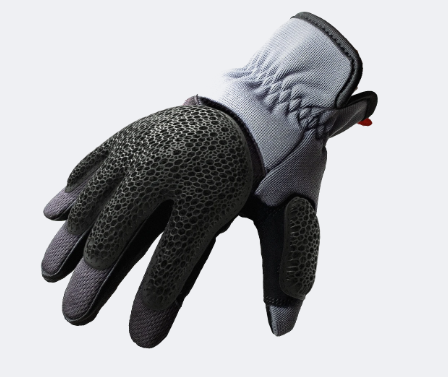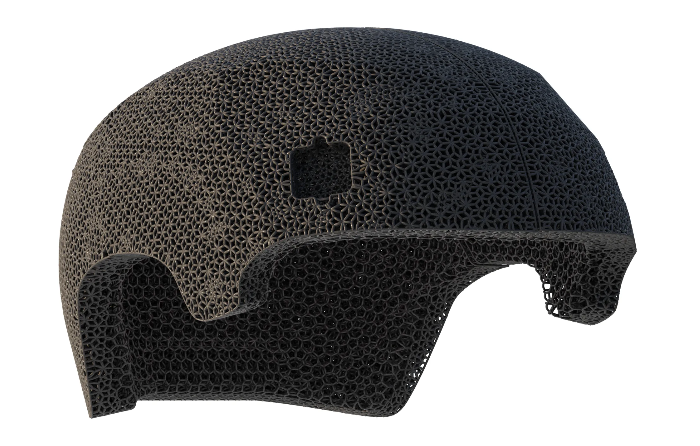Carbon has added three new resins, EPU 43, EPU 45, and Henkel Loctite IND147. The soft, energy-damping elastomer EPU 43 is suitable for comfort padding for helmet liners and safety gloves. Carbon claims it is durable under high cycle flexing. EPU 45 is the material of choice for sports padding and seating because it offers the highest damping performance and printability.
“EPU 43 and EPU 45 are the future of impact protection, providing the benefits of performance, comfort, and durability that come with Carbon’s elastomers,” said Jason Rolland, SVP of Materials at Carbon. “EPU 43 and 45 further exemplify our commitment to providing a robust and complete idea-to-production platform.”

Features of EPU 43, EPU 45, and Henkel Loctite IND147
EPU 45 is a strain-rate sensitive material that toughens to absorb energy at maximum impact rates, allowing for the creation of breathable lattice structures that are adjusted for comfort at low impact speeds and energy absorption at maximum impact speeds.
EPU 45 possesses the toughness and recovery required to withstand repeated, high-energy impacts in various environments. In terms of Carbon’s elastomers, EPU 45 has the maximum green strength, making it possible to print a variety of part shapes and lattice geometries with a high yield.
EPU 43 has a moderate stiffness, allowing for softer, more conforming lattice structures. Through flexing cycles in a variety of temperature and humidity environments, EPU 43 provides moderate stiffness, ideal damping, and adequate durability. A wide range of production shapes can be produced with EPU 43’s moderate green strength printing, which results in a high yield. EPU 43 has been proven to be suitable with products like the CCM Hockey helmets and Hard Head Veterans, and products utilizing EPU 45 will soon be available on the market.
Henkel Loctite IND147™ is a rigid, black resin with superior surface quality, high stiffness, high-temperature resistance, and dimensional stability. It is a low-cost and quick method of producing low-pressure moldings, baking fixtures, and small components with complex geometries used in high-heat applications in the industrial, consumer, and automotive markets – says the company. Furthermore, because Loctite IND147 is a one-part resin, it is simple to use and process.
Loctite® IND147 is a third-party resin offered by Carbon materials partner Henkel that has been tested and approved for use with the Carbon platform. Henkel and Carbon also announced an expansion of their strategic partnership to offer several new resins on the Carbon idea-to-production platform in 2023.
Carbon’s collaboration with Henkel
“The expansion of our partnership with Carbon follows the success we’ve had together and builds on our shared focus on production applications and better end-use parts for our customers,” said Sam Bail, Director of 3D Printing Sales from Henkel. “Carbon’s platform allows us to provide LOCTITE 3D printing’s unique industrial resins, creating more value for our customers.”
This expansion comes on the heels of the successful 2020 launch of LOCTITE IND405 Clear, a tough, clear resin used in manufacturing applications such as housings and enclosures.
This strategic alliance builds on Carbon’s open material platform and DLS printing process, as well as Henkel’s materials expertise, to provide a portfolio of resins while broadening the opportunities for end-use parts in less time.
“We’ve shared a great deal of success with Henkel and are thrilled to further expand our partnership with these new resins,” said the SVP of Materials from Carbon. “With this partnership, Carbon has the most comprehensive one-part and dual-cure resin portfolio in the industry, providing an open solution for customers to create better products in less time.”

An abundance of resin materials
Previously, international polymer manufacturer igus alleged that its new Digital Light Processing (DLP) 3D printing material lasts up to 60 times longer than competitors. The iglide i3000 was developed using igus’ proprietary “tribo-technology,” which is tribologically optimized to create accurate, extremely wear-resistant parts. igus claims that its resin is ideal for DLP 3D printing small, intricate parts like 0.2mm-tooth module gears, along with any others that necessitate filigree recesses or ultra-fine drill holes.
Furthermore, Liqcreate, an independent Netherlands-based photopolymer manufacturer, recently added an elastic engineering resin to its 3D printing materials portfolio. Elastomer-X was developed to be one of the softest elastomer resins available, with high elongation, good tear strength, and a Shore A hardness. It has a hardness of only 43, making it pliable like silicones and TPUs. According to the company, these properties make Liqcreate’s newest polymer ideal for printing grommets, elastic industrial parts, soft end-of-arm tooling (EOAT) for robots, digital lattice foams, and grommets.
Follow this link for all the Formnext 2022 news.
To stay up to date with the latest 3D printing news, don’t forget to subscribe to the 3D Printing Industry newsletter or follow us on Twitter, or like our page on Facebook.
While you’re here, why not subscribe to our Youtube channel? Featuring discussion, debriefs, video shorts, and webinar replays.
Are you looking for a job in the additive manufacturing industry? Visit 3D Printing Jobs for a selection of roles in the industry.
Feature image shows highly flexible impact-padded work gloves by Carbon. Image via Carbon.


